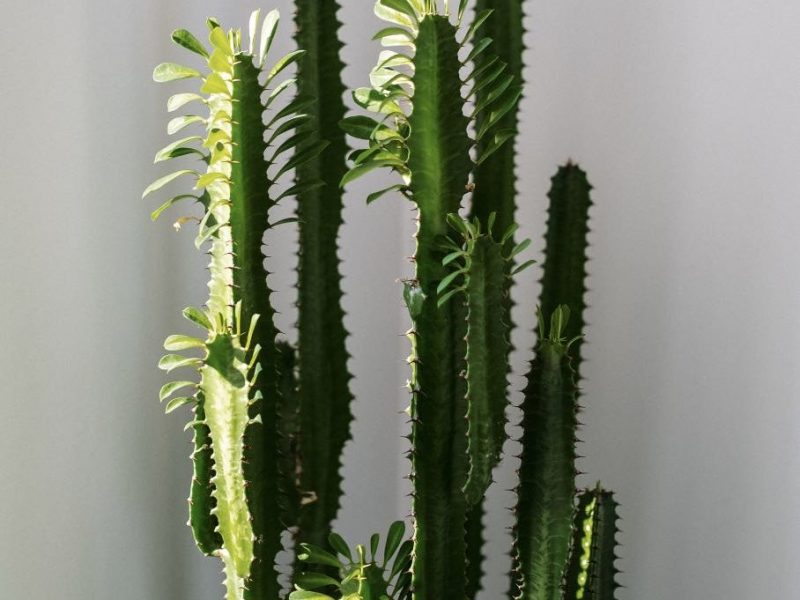
Native to Central Africa, although the African Milk Tree might look like a cactus, it’s actually a succulent which changes how you care and spot problems a little. If you have started to notice some of the leaves on your African Milk Tree have turned yellow, this can mean there is something wrong with either your plant’s environment or the care it’s receiving.
In this post, we will go through each of the different reasons why African Milk Tree leaves turn yellow so you can see which one is affecting your plant and fix the problem straight away.
Underwatering
If the leaves are turning quite dry and crispy all over as well as yellow then it may be due to a consistent lack of water. Although African Milk Trees can deal with drought, you still have to get the right balance when watering to avoid it drying out. We always recommend a little but often approach to avoid any watering issues.
If you think that your African Milk Tree has been underwatered then check the soil before you do or change anything! You want to be sure that this is the cause otherwise you may very quickly be overwatering and causing a whole wealth of other problems (African Milk Trees are more sensitive to overwatering than underwatering so err on the side of caution). Once you are sure that the soil is bone dry, then slowly reintroduce watering. Your first instinct might be to drown your African Milk Tree in water but this can actually cause more damage and more yellow leaves. This is because plants get shocked by a sudden change in environment.
Water your African Milk Tree a little bit once a day for about a week. After then you want to go back to a more normal care routine, making sure to check the moisture in the soil frequently to avoid any yellow leaves from developing again!
Overwatering
One common cause of yellow leaves on African Milk Trees is overwatering and subsequent root rot. This usually shows itself by the lowest leaves turning yellow first. If you think that your African Milk Tree is suffering from overwatering and root rot, the best thing to do is to take your plant out of its pot immediately and inspect the root system. Carefully trim away any rotten roots as this will encourage the new healthy roots to grow. If the potting mix of your African Milk Tree is still soggy and waterlogged, replace it immediately. Don’t wait for it to naturally dry out as this risks causing more harm to your African Milk Tree and it can cause more yellow leaves.
Over the next few weeks, you need to water your African Milk Tree less than you were doing before so that it can start to recover. Using a moisture meter is a great way to know when it’s time for a water. You will also want to adjust your watering schedule depending on the seasons, to ensure that you are cutting down on watering over the colder, darker months of autumn and winter.
Top tip: to avoid the roots of your plant sitting in water for days, remove any excess water that has run out of the drainage holes into your saucer or planter.
Cold Temperatures
As they are native to central Africa, African Milk Trees prefer slightly warmer temperatures so will struggle in cold homes. Over time, the cold air will impact your African Milk Tree’s health and it may be what is causing them to develop yellow leaves. Make sure your African Milk Tree is away from all air conditioning vents, drafty windows or doors as the colder air can shock your plant. You can always pick up a digital thermometer to check the temperature of the spot your African Milk Tree is sitting in to check whether it needs to be moved to a new, warmer spot in your home.
Natural Ageing
If it is the lower leaves on your African Milk Tree that are turning yellow then this may be simply natural ageing. Over time, your African Milk Tree will drop some of its oldest leaves in favour of growing bigger healthier new ones. This is completely natural and isn’t something you did wrong or anything to worry about. The rate of natural ageing should be 1 or 2 of the oldest leaves every few months. Monitor the rate of yellowing to see if it is speeding up or well above this rate as there might be another cause you need to look out for.
Those are the most common reasons why the leaves on your African Milk Tree are turning yellow. We recommend going through each of the reasons one by one to see what fits with your plant. After changing something about your plant’s environment or care, we recommend keeping a very close eye on your plant to see if the problem is getting better or if new leaves are also turning yellow. As some factors cause very similar symptoms, it can sometimes be difficult to know exactly what to change so make sure to monitor the rate of yellowing.
To discover more about how to care for your plant how to spot other common issues, check out our African Milk Tree care guide.
If you are struggling to revive your plant and the yellowing just seems to be getting worse, then you might need to propagate your African Milk Tree to save some of the healthy sections.














